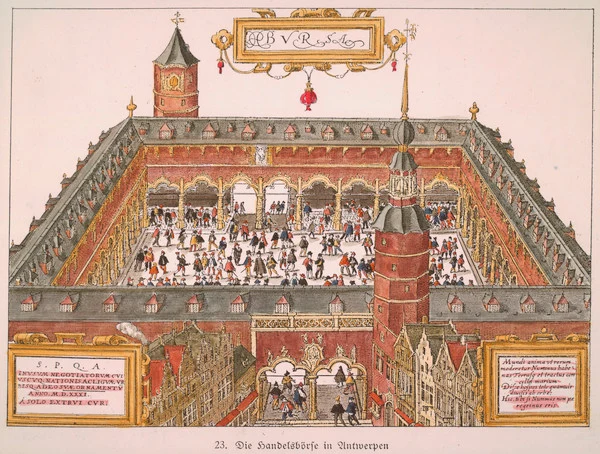If you use your credit card in Bruges or Antwerp —-even for the most basic transaction— you are probably unaware that you are part of a centuries-old Dutch tradition. Your transaction mimics a long legacy of business practices historically linked to the Flanders region of Belgium. Allow me to explain…

In the late 13th_ century, the port of Bruges could proudly count itself as one of the most important trading centres in Europe. It attracted traders and foreign merchants from across the continent where they could conveniently conduct business. A Bruges innkeeper named Robert van de Beurze (more about him later) organized the first trading-specific venue where buyers and sellers could meet face-to-face to conduct business. For a few centuries the van de Beurze edifice, the Bourse at Bruges, remained the epicentre of Northern European trade. However, after some political in-fighting, some social upheaval, and the gradual silting of the river Reie and the harbour, the trading centre of gravity shifted to Antwerp.
By the 16th century, Antwerp found itself favorably positioned between the trading giants of Europe. Italy (think: Genoa and Venice) traded gems, mineral dyes, silk, spices, and glass. To the north and east Germany (think: The Hanseatic League) shipped in furs, timber, broadcloth, wheat, flax, salt, etc. Additionally, through Antwerp flowed a substantial amount of wealth from the Spanish and Portuguese Colonial Empires. Gold and silver bullion, spices, tobacco, sugar, exotic foodstuffs, wool, etc. were collectively processed in the thriving port of Antwerp. To assist the visiting traders Antwerp developed an effective “merchant friendly” infrastructure called “nation houses.” These entities rented warehouses and common sites for commercial transactions. One such nation house located within Antwerp’s city center was the Handelsbeurs complex— an enclosed, mall-like city block exclusively designed for traders and merchants. Over time trading in tangible, hands-on goods became secondary and what emerged was the incorporation of a new set of financial instruments. Shared information from international clientele morphed into the ability to set interest rates, future considerations, bills of lading, and credit replete with currency exchanges. For the next 500 years, The Handelsbeurs complex housed the Bourse of Antwerp — “the mother of all stock exchanges.” It was the epicenter of the “golden age of Antwerp” and inspired the design and function of future stock exchanges throughout the world. Examples include London’s Royal Exchange, Amsterdam and Brussels Euronext and New York’s Wall Street.

In 1997, the stock exchange building—The Handlesbeurs complex— had lost its purpose and the world’s first stock exchange moved to Brussels. The building was abandoned and doomed for destruction. However, in 2013 the Marriott Hotel chain and city officials partnered up to restore this classic beauty to its present glory. Today Marriot’s Sapphire House Antwerp sits upon the Handelsbeurs complex.
To be sure, inserting/swiping or tapping your credit card today in Antwerp’s Handlebeurs is not the exact same thing as the Bruges and Antwerp trading practices of centuries past. But they do have much in common. Both are examples of financial instruments that allow for the flow of money by providing a service. Both focus on the circulation of money, and investment management, involve some degree of risk, have tax implications, establish contract agreements and are instruments of credit, exchange, and distribution.
Fun Facts
- The entomology of the word Bourse ( Old French for stock exchange) is interesting but unclear. It is thought the word is derived from the Robert van der Beurze family who in the late-1200’s had a hotel in Bruges which catered to international merchants. His family name may have given rise to the word “bourse.” Another theory is that the term “bourse” is derived from the Latin word “bursa” or “the skin stripped off a hide.” Perhaps in reference to a bad investment? The original Bourse at Bruges building still exists and was restored to its original medieval appearance in 1947.
- During remodeling of the Handelsbeurs complex, several archaeological finds were discovered; iron age urns, fireplace ovens, a medieval garden and “pile pits’ which point to unique timber construction
- In the Golden Age of Antwerp, the metropolis had 100,000 inhabitants of which 10,000 were foreign merchants.
- The 5-star Sapphire House Antwerp has located in the historic center — a 10-minute walk from Antwerp’s Central Station. No surprise, they accept credit cards! (sarcasm!)
Dear reader,
Opinions expressed in the op-ed section are solely those of the individual author and do not represent the official stance of our newspaper. We believe in providing a platform for a wide range of voices and perspectives, even those that may challenge or differ from our own. We remain committed to providing our readers with high-quality, fair, and balanced journalism. Thank you for your continued support.



